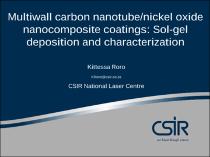 ResearchSpace
ResearchSpace
Multiwall carbon nanotube/nickel oxide nanocompositecoatings: Sol-gel deposition and characterization
JavaScript is disabled for your browser. Some features of this site may not work without it.
- ResearchSpace
- →
- Research Publications/Outputs
- →
- Conference Publications
- →
- View Item
| dc.contributor.author |
Roro, Kittessa T

|
|
| dc.date.accessioned | 2011-12-13T14:49:53Z | |
| dc.date.available | 2011-12-13T14:49:53Z | |
| dc.date.issued | 2011-09 | |
| dc.identifier.citation | Roro, K.T. 2011. Multiwall carbon nanotube/nickel oxide nanocompositecoatings: Sol-gel deposition and characterization. ASSAf-DST-NRF Second Annual South African Young Scientists Conference, Diep in Die Berg Conference and Function Centre, Pretoria, 26-27 September 2011 | en_US |
| dc.identifier.uri | http://hdl.handle.net/10204/5406 | |
| dc.description | ASSAf-DST-NRF Second Annual South African Young Scientists Conference, Diep in Die Berg Conference and Function Centre, Pretoria, 26-27 September 2011 | en_US |
| dc.description.abstract | Due to their unique electronic and optical properties nanocomposite materials have wide range of applications in solar energy conversion. In this study, multiwalled carbon nanotubes (MWCNTs)/Nickel oxide (NiO) nanocomposites were successfully prepared by a sol-gel process and coated on aluminium substrate. The MWCNTs were chemically functionalized and then added into NiO alcogels which is followed by magnetic stirring in order to homogeneously disperse in the NiO matrix solution. The morphology of the nanocomposite thin films showed that the MWCNTs were embedded in NiO nano-particle matrix. HRTEM confirmed the fact that the MWCNTs were decorated by the NiO nano-particles. Raman spectra for functionalized MWCNTs displayed a red shift from the pristine MWCNTs phonons suggesting successful purification/functionalization. The spectrum for the MWCNTs/NiO nanocomposite presented both the TO and LO phonons of NiO, and the D and G bands of the MWCNTs. Redshifts and blue shifts of the NiO phonons and the MWCNT phonons suggested that the vibrational properties of both materials were changed to form new nonocomposite vibrational properties. The solar absorptance of pure NiO was found to be 0.35 and that of nitrogenated NiO to be 0.55. However, the absorptance for the functionalized MWCNTs/NiO nanocomposite films gave 0.84. The thermal emittance was about 0.1. These preliminary results suggest that MWCNTs/NiO nanocomposite material is suitable for solar thermal applications. | en_US |
| dc.language.iso | en | en_US |
| dc.relation.ispartofseries | Workflow request;7310 | |
| dc.subject | Composite materials | en_US |
| dc.subject | Coating materials | en_US |
| dc.subject | Sol-gel processes | en_US |
| dc.subject | Nanostructured materials | en_US |
| dc.subject | Multiwall carbon nanotube | en_US |
| dc.subject | Nickel oxide nanocomposite coatings | en_US |
| dc.title | Multiwall carbon nanotube/nickel oxide nanocompositecoatings: Sol-gel deposition and characterization | en_US |
| dc.type | Conference Presentation | en_US |
| dc.identifier.apacitation | Roro, K. T. (2011). Multiwall carbon nanotube/nickel oxide nanocompositecoatings: Sol-gel deposition and characterization. http://hdl.handle.net/10204/5406 | en_ZA |
| dc.identifier.chicagocitation | Roro, Kittessa T. "Multiwall carbon nanotube/nickel oxide nanocompositecoatings: Sol-gel deposition and characterization." (2011): http://hdl.handle.net/10204/5406 | en_ZA |
| dc.identifier.vancouvercitation | Roro KT, Multiwall carbon nanotube/nickel oxide nanocompositecoatings: Sol-gel deposition and characterization; 2011. http://hdl.handle.net/10204/5406 . | en_ZA |
| dc.identifier.ris | TY - Conference Presentation AU - Roro, Kittessa T AB - Due to their unique electronic and optical properties nanocomposite materials have wide range of applications in solar energy conversion. In this study, multiwalled carbon nanotubes (MWCNTs)/Nickel oxide (NiO) nanocomposites were successfully prepared by a sol-gel process and coated on aluminium substrate. The MWCNTs were chemically functionalized and then added into NiO alcogels which is followed by magnetic stirring in order to homogeneously disperse in the NiO matrix solution. The morphology of the nanocomposite thin films showed that the MWCNTs were embedded in NiO nano-particle matrix. HRTEM confirmed the fact that the MWCNTs were decorated by the NiO nano-particles. Raman spectra for functionalized MWCNTs displayed a red shift from the pristine MWCNTs phonons suggesting successful purification/functionalization. The spectrum for the MWCNTs/NiO nanocomposite presented both the TO and LO phonons of NiO, and the D and G bands of the MWCNTs. Redshifts and blue shifts of the NiO phonons and the MWCNT phonons suggested that the vibrational properties of both materials were changed to form new nonocomposite vibrational properties. The solar absorptance of pure NiO was found to be 0.35 and that of nitrogenated NiO to be 0.55. However, the absorptance for the functionalized MWCNTs/NiO nanocomposite films gave 0.84. The thermal emittance was about 0.1. These preliminary results suggest that MWCNTs/NiO nanocomposite material is suitable for solar thermal applications. DA - 2011-09 DB - ResearchSpace DP - CSIR KW - Composite materials KW - Coating materials KW - Sol-gel processes KW - Nanostructured materials KW - Multiwall carbon nanotube KW - Nickel oxide nanocomposite coatings LK - https://researchspace.csir.co.za PY - 2011 T1 - Multiwall carbon nanotube/nickel oxide nanocompositecoatings: Sol-gel deposition and characterization TI - Multiwall carbon nanotube/nickel oxide nanocompositecoatings: Sol-gel deposition and characterization UR - http://hdl.handle.net/10204/5406 ER - | en_ZA |





